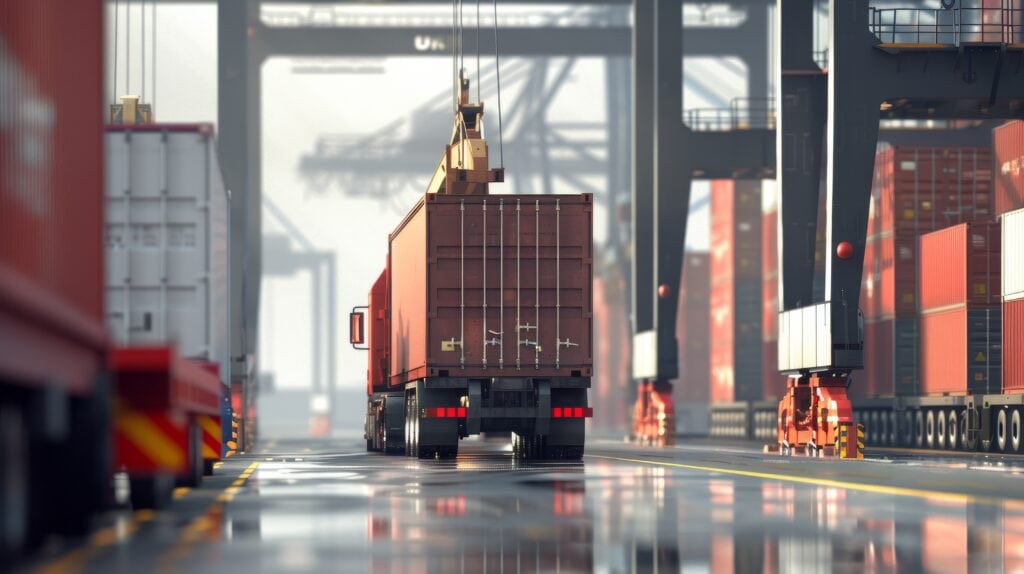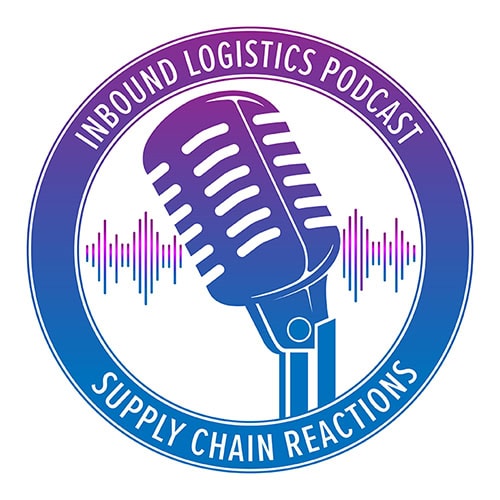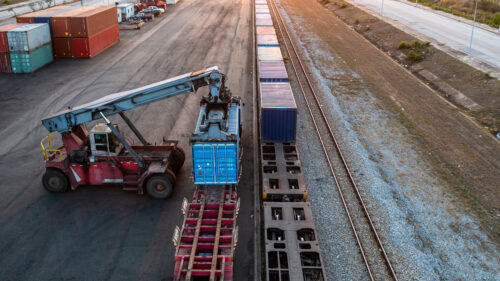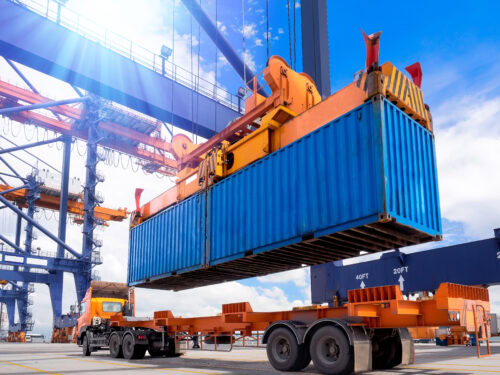Transloading: Key Benefits and Best Practices for Your Logistics Needs

Discover how transloading can improve your supply chain efficiency. Learn the key benefits, cost savings, and best practices to optimize your logistics operations.
Transloading is growing in popularity with devotees of Inbound Logistics magazine. Why and what exactly is transloading? And why do shippers love transloading?
Here’s the answer! Transloading is essentially the process of transferring goods from one mode of transportation to another.

Learn more about the processes, benefits, and challenges of transloading in this Inbound Logistics Education Series podcast, voiced by IL AI Audio©.
This often involves moving freight between:
- Trucks and trains: This is a very common scenario.
- Ships and trucks or trains: For international shipping.
- Different types of railcars:To match the cargo to the destination.
Here’s why practitioners of Inbound Logistics find transloading so valuable:
- Cost Efficiency:
- Rail transport is often more economical for long distances, especially for bulk goods. Transloading allows shippers to leverage this cost advantage.
- By using trucks for the “first mile” and “last mile” and trains for the long distances in the middle, shippers cut transportation costs.
- Increased Flexibility:
- Infrastructure work around: Many destinations have zero direct rail access. Transloading bridges this gap, enabling shippers to reach a wider range of locations.
- It allows for the consolidation or deconsolidation of shipments, providing greater control over distribution.
- New Customers & Markets:
- Transloading opens up access to vast rail networks, extending a shipper’s reach to markets that would otherwise be difficult or expensive to serve.
- Optimize Your Supply Chain:
- Shippers utilize the most efficient mode of transportation for each segment of their moves
- It can also help with the flow of goods, and allow for efficient storage of goods in transit.
Transloading provides a way to combine the benefits of different transportation modes, leading to more efficient, cost-effective, and flexible shipping solutions.
What is the importance of transloading services in logistics?

Transloading plays an integral role in modern logistics. How? By optimizing the movement of goods throughout the supply chain, the transloading benefit becomes evident in addressing significant logistical challenges such as shipping delays and equipment shortages. Here’s why it’s crucial:
Flexibility: Transloading facilities can handle various cargo types and sizes while providing maximum flexibility for delivery timelines and destinations. This enables companies to adapt their shipping strategies to their specific needs, even for complex logistics moves. However, transloading challenges such as increased risk of damage due to additional handling must be managed through measures like freight insurance and secure packaging.
Speed: Provides a consistent service level with tighter transit standard deviation than a traditional interior point intermodal (IPI) move.
Optimized inventory management: Enables better positioning of our customer’s goods by creating a flexible mechanism to align with customer demand and production.
Cost and efficiency: Through the consolidation of product, transloading reduces the amount of transportation needed by compressing inbound shipments to outbound equipment. It allows companies to leverage the most economical transport mode for each leg of the journey. By utilizing the most suitable transport mode at each stage (train, truck, ship), transloading can expedite deliveries while providing more reliability for getting goods to customers faster. Understanding how transloading works, particularly the efficiency of combining rail and truck transport, highlights its application in different business scenarios, leading to cost savings and direct delivery to retailers.
Introduction to Transloading
Transloading is a logistics process that involves transferring goods from one mode of transportation to another during the shipping process. The purpose of transloading is to optimize the movement of goods throughout the supply chain, reducing transportation costs and increasing efficiency. By using transloading services, logistics companies can adapt to changes in demand and unexpected logistical challenges, ensuring that shipments reach their final destinations quickly and cost-effectively. This flexibility allows companies to switch between different transportation modes, such as from rail to truck, to best suit their needs and minimize overall shipping costs.
Definition and Purpose
Considerations when using transloading facilities
Find a qualified transload provider: Liability can be decreased by engaging a certified provider with a national or global presence. Transloading is the process of moving goods between different modes of transportation during their journey, often occurring at specialized facilities equipped for various types of cargo.
Damage risk: Extra handling increases cargo damage. The transloading process involves transferring goods between different modes, such as from trucks to rail cars and vice versa, and requires effective coordination and communication to minimize damage. Delicate products could be subjected to damages if the transload provider does not take necessary precautions.
Inventory management: Requires clear procedures and technologies to track goods during transfer.
Transloading Facilities and Equipment
Transloading facilities are specialized locations where goods are transferred from one mode of transportation to another. These facilities are equipped with various equipment and technology to handle different types of cargo, including bulk goods, building materials, and palletized freight. The equipment used in transloading facilities includes forklifts, pallet jacks, cranes, and conveyors, which are designed to efficiently transfer goods between transportation modes. This versatility ensures that a wide range of products, from heavy machinery to delicate household goods, can be moved seamlessly through the supply chain.
Transload Facility Operations
Transload facility operations involve the coordination of multiple activities, including receiving and inspecting goods, transferring goods from one mode of transportation to another, and loading goods onto the next mode of transportation. Facility managers play a crucial role in ensuring that transloading operations are carried out safely and efficiently, using standard operating procedures to minimize the risk of damage or loss of goods. Transloading facilities are strategically located near transportation hubs, such as ports, rail yards, and trucking terminals, to facilitate the transfer of goods between different transportation modes. This strategic positioning helps in reducing transit times and improving the overall efficiency of the supply chain.
Equipment and Technology
The equipment and technology used in transloading facilities are designed to handle a wide range of cargo types and sizes. Specialized equipment, such as container ships and purpose-built container ships, are used to transfer goods between ocean freight and land transportation modes. Other equipment, such as flatbed trucks and trailers, are used to transfer goods between truck transportation and rail transportation modes. The use of technology, such as transportation management systems (TMS) and logistics software, helps to streamline transloading operations, reducing costs and increasing efficiency. By leveraging these equipment and technology, logistics companies can optimize their transloading operations, improving supply chain flexibility and reducing transportation costs.
Is transloading right for your business and logistics companies’ shipping needs?

Transloading can be a game-changer for managing your logistics with ease. Consolidating shipments into one container can enhance efficiency and potentially reduce transportation costs.
Consider transloading if:
- You want to manage the flow of your cargo more effectively and efficiently. Ensuring goods are correctly loaded is crucial for efficient transportation.
- You frequently ship concentrations of volume to specific ports of entry. Consolidating multiple shipments can optimize transportation efficiency and costs.
- You deliver to diverse inland locations with varying accessibility (e.g., remote areas).
- Cost reduction is a priority; you can leverage outbound compression in a variety of transportation modes.
- You handle a variety of cargo sizes and types, allowing for consolidation.
How It Is Done
The way a product is transloaded depends on the product type. Transloading equipment includes forklifts, conveyors, pumps, cranes and loaders.
- For products like lumber, paper and palletized goods
Conveyor
- For bulk products like sand, soda ash, grains, flour and sugar
Pump/Pneumatic Transfer
- For products like plastic pellets and liquids
Crane
- For large, heavy products like steel beams, rebar, pipe and wind components
Front-End Loader
- For products like rock, salt, and other minerals and aggregates
Is Transloading For Your Supply Chain?
Could your business benefit from the best of rail and over-the-road transportation? Transloading can significantly lower transportation costs when shipping goods by allowing efficient transfer between different modes of transport. Bottom line – transloading allows you to leverage infrastructure investment made by railroads, ports, intermodal providers and more. Efficient transloading strategies are crucial to ensure timely final delivery.
We hope we at Inbound Logistics have provided enough information to evaluate transloading as a viable option. Utilizing trucks for final delivery can further optimize the logistics process, ensuring that goods reach their final destination efficiently.
